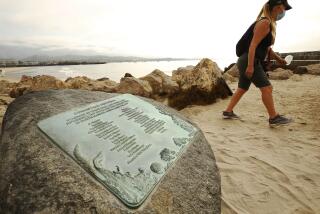Sub Captain’s Management Style Criticized at Navy Court of Inquiry
PEARL HARBOR, Hawaii — The Navy court of inquiry into the Greeneville collision is increasingly critical of the way the submarine captain trained and supervised sailors entrusted with operating the sonar system meant to safeguard against collisions.
On Friday, the three admirals investigating the Feb. 9 collision with a Japanese fishing vessel that took nine lives stepped up their criticism of Cmdr. Scott D. Waddle for allowing sailors to modify their work schedules and frequently change places in the sonar room.
The result, the admirals suggested, was a lack of consistency and continuity in tracking and analyzing sounds emitted by other ships.
Vice Adm. John B. Nathman, the court’s president, noted that of 13 work stations on the control deck, nine were being handled by crew members who had swapped with other sailors. “It doesn’t seem like a very efficient way to operate a ship, does it?” Nathman said.
Rear Adm. Paul F. Sullivan, a veteran submariner, expressed doubt after several enlisted personnel testified that everything was functioning fine aboard the ship on the day of the collision and that Waddle was an excellent skipper. “These are very professional young men, but I get the sense that they’re in denial about how this terrible tragedy happened,” Sullivan said.
A sonar supervisor and a sonar analyst have requested Navy lawyers to represent them, although the two have not been added to the official list of those being scrutinized for possible negligence or dereliction of duty.
Testimony showed that Waddle, a popular commanding officer with many of his sailors, allowed frequent changes in the work schedules, known in Navy-ese as the watch bill.
The result, the admirals suggested, was that sailors did not provide key information about ships in the area to personnel taking their places and failed to function as a team in swapping and analyzing such key information.
One technician took a 10-minute cigarette break in the minutes before the collision and, according to testimony, did not receive a briefing on how the sonar picture had changed when he returned.
Unaware that the Ehime Maru was steaming directly toward the Greeneville, Waddle ordered a rapid surfacing maneuver to impress 16 civilian visitors on board. The 6,500-ton sub sliced through the hull of the 190-foot fishing vessel, which sank within 10 minutes.
Tracking and analyzing sonar data is a labor-intensive, collaborative activity, in which enlisted personnel work closely with officers.
Under questioning by the admirals, the sonar supervisor, Edward McGibboney, conceded that he did not ask Waddle for more time to take readings after the sub performed several high-speed underwater maneuvers, which can render sonar information meaningless.
Rear Adm. David M. Stone, the third admiral on the court, noted that a report by a sonar supervisor assigned to the Greeneville only days before the collision noted “numerous deficiencies” in training.
The deficiencies, the report noted, were particularly acute in the difficult task known as target motion analysis, by which sonar technicians take raw data and determine the speed, bearing and distance of ships in the area.
In fact, several crew members were left ashore Feb. 9 to receive training in those skills, according to testimony.
The deficiencies, as spotted by the new chief, apparently had persisted during the years when Waddle was giving high marks to his crew and, in turn, being highly rated by his own superiors.
The court is reviewing what, if any, punishment should be meted out to Waddle, executive officer Lt. Cmdr. Gerald K. Pfeifer and Lt. j.g. Michael J. Coen, the officer of the deck at the time of the collision.
Waddle has offered to testify only if he is promised that his words will not be used against him if he is court-martialed. Adm. Thomas Fargo, commander of the Pacific Fleet, still is weighing that request.
Late Friday, a widow of one of those killed in the collision handed Waddle a letter saying that “your submarine killed my husband” and that it pains her to see Waddle entering the court each day smiling and holding his wife’s hand. “I will never be able to hold my husband’s hand again,” Naoko Naka wrote.
Waddle, tall, with an outgoing, confident manner and a burly appearance, is an officer about whom there are sharply differing opinions.
While his sailors respected him greatly, his executive officer has indicated that he thought Waddle was given to pushing the submarine too quickly and ignoring advice of junior officers, according to testimony.
Rear Adm. Al Konetzni, commander of the Pacific Fleet submarine service, testified that he viewed himself as Waddle’s mentor, a sign that Waddle was destined for promotion.
But Capt. Robert L. Brandhuber, Konetzni’s chief of staff, said he had heard that Waddle was “all show, no go.”
Brandhuber’s son-in-law, Lt. Cmdr. Tyler Meador, was the engineer on the Greeneville. He testified Thursday that he never discussed the captain or other “gossip” with his father-in-law.
More to Read
Sign up for Essential California
The most important California stories and recommendations in your inbox every morning.
You may occasionally receive promotional content from the Los Angeles Times.










